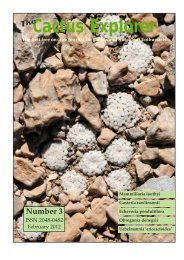Cactus Explorers Journal - The Cactus Explorers Club
Cactus Explorers Journal - The Cactus Explorers Club
Cactus Explorers Journal - The Cactus Explorers Club
Create successful ePaper yourself
Turn your PDF publications into a flip-book with our unique Google optimized e-Paper software.
<strong>The</strong> <strong>Cactus</strong> Explorer ISSN 2048-0482 Number 4 May 2012<br />
thE lovE of Books<br />
News of Recent Publications. A Reminder of Old Favourites.<br />
Many cactophiles enjoy reading about their plants, particularly in the winter when our<br />
collections are less demanding. This feature aims to provide you with inspiration.<br />
101 <strong>Cactus</strong> del Perú<br />
Peru is surely one of the most important<br />
countries when considering the cactus flora of<br />
the world. It has a remarkable diversity of<br />
biogeographic zones ranging from the very<br />
dry coastal strip to tropical rain forest. Many of<br />
these zones support cacti. Some species are<br />
small and hard to find but others are dramatic<br />
trees.<br />
Dr. Carlos Ostolaza is very well known to<br />
enthusiasts around the world for his work<br />
with cacti in Peru over many years. He has<br />
been a pioneer in the education of the Peruvian<br />
people about the importance of their floral<br />
heritage and the need to conserve it. In 1987 he<br />
founded QUEPO, the Peruvian <strong>Cactus</strong> and<br />
Succulent Society and still edits their annual<br />
journal.<br />
This impressive book has been printed and<br />
published in Peru and, being written in<br />
Spanish, should further promote interest<br />
within the country. As in many countries, the<br />
cacti in Peru face pressures on their survival<br />
from infrastructure developments such as<br />
dams, roads and mines, as well as the<br />
expansion of agriculture. <strong>The</strong> long-term<br />
22<br />
conservation of cacti depends to a great extent<br />
on the value placed on them by the local<br />
people. It is to be hoped that books like this<br />
will help spread understanding of the plants<br />
and the need for their conservation.<br />
<strong>The</strong> volume is hardbound, 240 x 273mm<br />
landscape, 256 pages. <strong>The</strong>re are 546 colour<br />
photographs, all reproduced at a good size.<br />
<strong>The</strong> non-technical text is written in Spanish.<br />
<strong>The</strong> 101 species described are about 40% of<br />
the cacti found in Peru and have been well<br />
chosen to represent the diversity of the family.<br />
Many of the featured species are popular in<br />
cultivation and are usually illustrated in<br />
culture and also in habitat. A brief description<br />
is given for each taxon together with an<br />
indication of its known distribution.<br />
Some potential readers might be put off by<br />
the Spanish text but the pictures alone make it<br />
a valuable reference and the text is quite easy<br />
to follow even if you understand only a little of<br />
the language.<br />
You can watch the launch of the book on<br />
youtube.<br />
Carlos tells me that Mildred Margot Canales<br />
Azabache has copies of the book in Spain<br />
available for sale at 60€. You can contact her by<br />
email.<br />
GC<br />
Looking for a second hand book?<br />
You can search the stock of book dealers<br />
around the world by using one of the<br />
specialist web sites for example:<br />
http://www.addall.com/Used<br />
http://www.bookfinder.com<br />
http://www.abebooks.com




